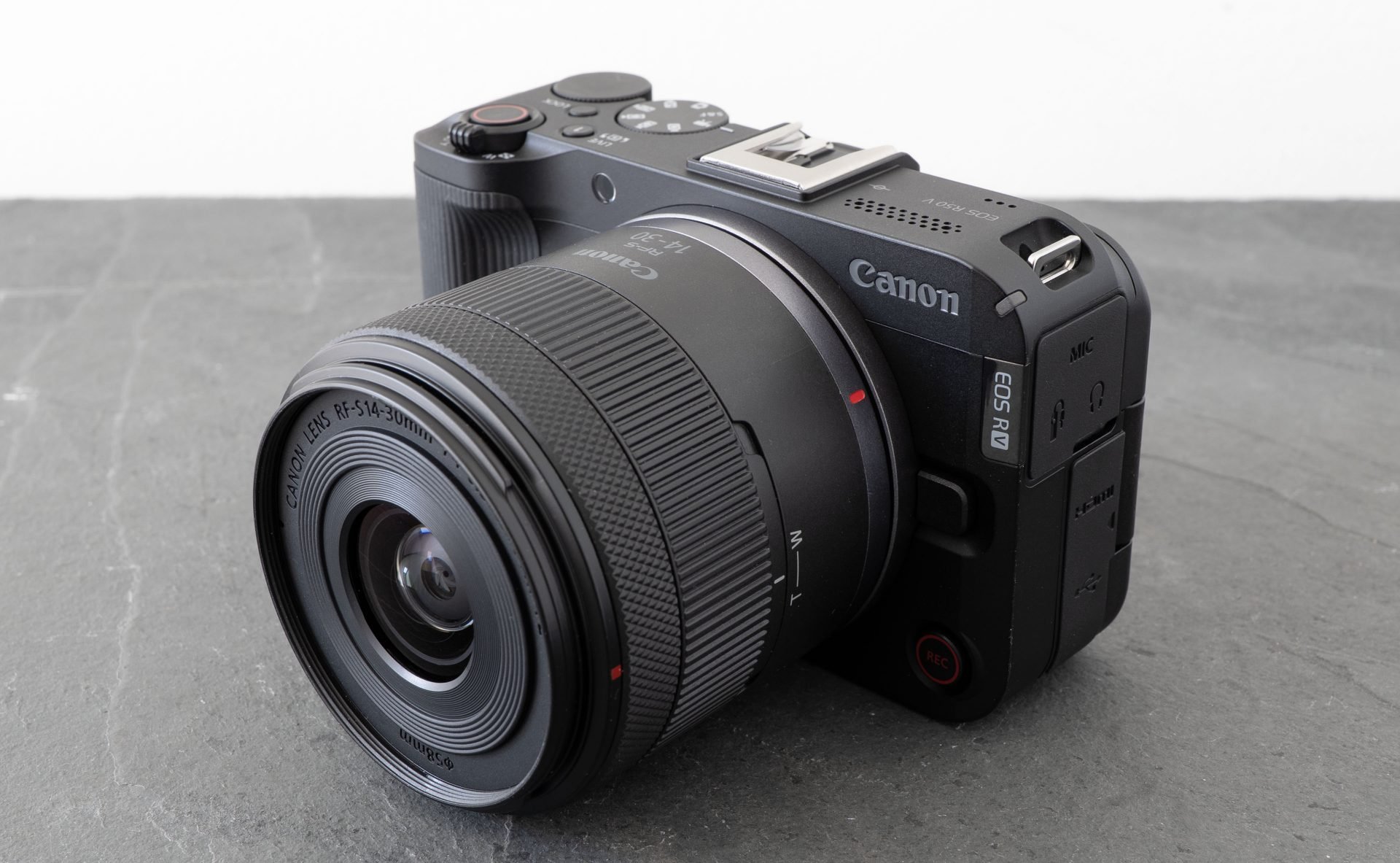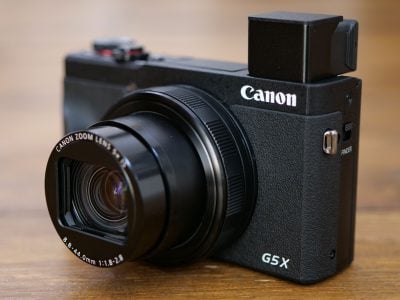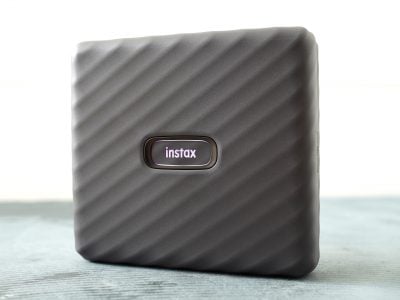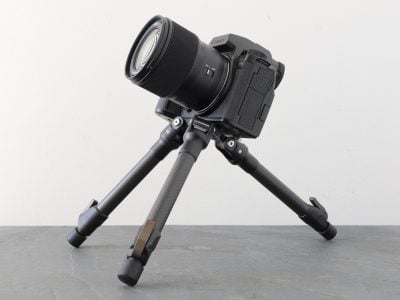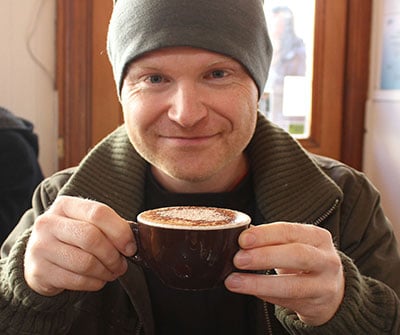Canon EOS R50 V review
-
-
Written by Gordon Laing
The Canon EOS R50 V is a mirrorless camera aimed at video creators who want a compact body with interchangeable lenses. It will take photos too, but it’s mostly designed for video.
Announced in March 2025 alongside the PowerShot V1, the R50 V is available body alone or in a kit with the new RF-S 14-30 f4-6.3 IS STM Power Zoom lens. Coincidentally the kit costs roughly the same as the new PowerShot V1. Add the kit zoom to the R50 V and the barrel will of course protrude further, but you’re getting the flexibility of a camera with interchangeable lenses and a bigger sensor behind them. You can see my first-looks review of the EOS R50 V in the video below, or keep scrolling if you prefer to read the written highlights!
So Canon’s V series has gone from just the original V10 to three models, all aimed at video creators but with different feature sets. As such I wouldn’t be surprised to see further V-series products in the future. In this respect it’s similar to Sony’s ZV series.
As you might expect given the name, the R50 V is a video-oriented version of the now two year old R50, and shares the same 24 Megapixel APS-C sensor with a RF lens mount. It can record uncropped oversampled 4k up to 30p, and now also offers 4k 50 and 60p albeit with a crop.
Measuring 119x74x45mm, it’s a little shorter and thinner than the R50, but at 370g including battery, essentially the same weight. It feels really light in your hands. The height saving comes from losing the viewfinder of the R50, in turn leaving composition entirely to the fully articulated touch screen which can of course flip-forward to face you, angle up or down for high or low angles, and back on itself for protection. Note the thumb wheel to the side which can also be tilted up, down, left and right to access other functions.
Personally speaking, I prefer to have a viewfinder as I find them easier to use than a screen even when making YouTube videos, but the R50 V’s target audience apparently mostly use screens alone. It’s the same approach seen on, say, Sony’s ZV-E10, and of course if you prefer to have a viewfinder and more of a hybrid experience, there’s still the standard R50 available.
On the top surface you’ll find the power switch in the corner around a thumb dial. To its left is a mode dial again aimed for video use. Of the eight positions, seven are dedicated to video, leaving one for stills with the various photo modes selected from menus or touch screen. Also note the soft-touch red record button in the corner with a collar to adjust the focal length on compatible Power Zoom lenses, like the new 14-30.
There’s also a multi-function shoe on the top, the same as the R50, so lacking the five pins for traditional accessories. Instead it’s designed for Multi-function accessories like optional microphones. Dear Canon, please please make an EVF accessory for cameras with this shoe.
Turning to the front, there’s a second record button in the lower left corner, handy when you’re in front of the camera.
Behind one flap on the left side are 3.5mm microphone and headphone jacks, the latter not available on the R50, and a jack for a remote cord. There’s also USB-C and Micro HDMI ports behind a second flap below. The USB port also supports UVC and UAC, allowing it to work as a standard webcam up to 4k 60p, during which it can also receive power over the same connection.
Under the camera you’ll find the battery compartment with the R50 V powered by the same LP-E17 as the R50, and this is also where you’ll insert an SD card for storage. Note the tripod thread on the underside, but also a second one on the grip side, allowing you to mount the camera vertically for more easily making tall content. Also note when you turn the camera for vertical framing, the icons and display details also turn to stay upright.
Now for the sensor which as mentioned earlier is the same 24 Megapixel APS-C part as the original R50, sporting Dual Pixel CMOS II autofocus. Like the R50, there’s no IBIS, but there is digital stabilisation available for video, while the new kit zoom also has optical IS.
In terms of video modes, the R50 V can record uncropped 1080 from 24 to 120p, and uncropped 4k up to 30p, the latter oversampled from 6k’s worth of data. A faster 4k 60 mode is also available, but with a crop. All modes support Servo AF continuous autofocus, including 4k 60 and 1080 120, and in my tests I managed just under 79 minutes of 4k 25p on a full battery before it ran out. There’s no active cooling, but there is the option to let the camera run hotter to extend times. I managed the maximum two hour clip length in 4k 25p under USB power. A Cinematic mode is also available which crops the image into a wider aspect ratio.
10-bit 4:2:2 video is available, while graders will be pleased to also find C-Log 3, again not present on the R50. As far as I could see, all video is encoded using Long GOP with no All-i options, but I could have missed them.
As for the new lens, you can see it demonstrating the power zoom feature in my video review above which can be operated either by the collar control on the body, or a spring-loaded ring on the lens barrel that’s pushed clockwise or anti-clockwise. There’s two zooming speeds depending how far you push either control
Next for a focusing and depth-of-field test using the 14-30 at 30mm f6.3 – that’s the maximum aperture here, so you’re not going to be getting hugely blurred backgrounds, but you can of course swap the lens for something longer and brighter if that’s the effect you’re after, like the RF 50mm f1.8. And now at 14mm f4, again the maximum aperture at the wide-end of the new zoom. This is equivalent to 22mm, so is delivering pretty wide coverage that’s ideal for environmental presentations and pieces to camera.
But many potential owners of the R50 V kit will be wanting to use it for handheld vlogging, so in my video review at the top of the page you’ll see lots of examples! Meanwhile audio can be recorded in 24 bit linear PCM with four channels, or 16 bit AAC in two channels. And finally, the R50 V also becomes Canon’s first camera to work with the new live switcher mobile app for live streaming with up to three cameras.
Just before wrapping-up a quick mention of the new RF-S 14-30 kit zoom, measuring 67mm in diameter, 62mm long and weighing 180g. It has two rings, a spring-loaded zoom control, followed by a smooth customisable control. At one end is a plastic mount without weather sealing, and at the other a 58mm filter thread. There’s optical stabilisation with a claimed four stops of compensation. The range on a Canon APS-C body is equivalent to 22-48mm, making it a bit wider than most at the short-end, while the aperture is fairly modest at f4 to 6.3, so don’t expect substantial blurring at either end of the range. I believe it should cost around £380 by itself.
And that’s all I can say for now until I spend more time with the camera. The EOS R50 V’s feature-set and design should certainly appeal to anyone who’s primary focus is filming video, although if you can live without C-Log, a headphone jack and the video-oriented body design, you could achieve mostly similar results with the original R50, while enjoying a built-in viewfinder and a slightly lower price tag thanks to age.
But to be fair, Sony’s been successful with the ZV-E10 II which costs a similar amount to the R50 V depending on region. It’s certainly becoming quite a crowded market though and any camera aimed at video creators will also have to compete with the DJI Osmo Pocket 3, my own preferred model for casual handheld work.
Check prices on the Canon EOS R50 V at B&H, Adorama, WEX UK or Calumet.de. Alternatively get yourself a copy of my In Camera book, an official Cameralabs T-shirt or mug, or treat me to a coffee! Thanks!
